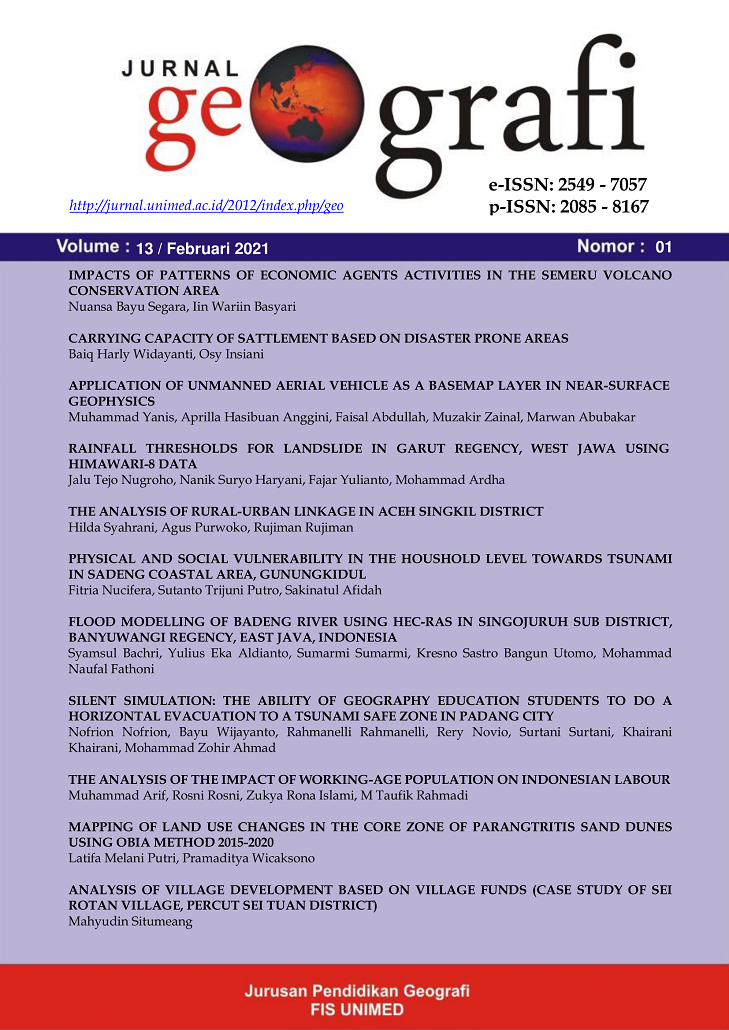APPLICATION OF UNMANNED AERIAL VEHICLE AS A BASE MAP LAYER IN NEAR-SURFACE GEOPHYSICS
DOI:
https://doi.org/10.24114/jg.v13i1.17818Abstract
The Geophysical method is operated by using physical parameters above the surface to estimate the subsurface structures. In data interpretation, all 3D surveys, i.e., magnetic, gravity, magnetotelluric, and airborne, are required for geographical conditions in the research area. In a large area, global DEM data is used to explain the field condition, but for local measurement, the data is not efficient due to low resolution (15-30 m/px). This research uses UAV technology to produce a high-resolution topography in local Geophysical measurement (500 x 600 m). The survey was conducted to map the coal structure in the subsurface. UAV data were also compared to SRTM (30 m/px) and DEMNAS (8 m/px) as global topography. Based on data processing, the UAV topographic was have a high resolution of 2.5 cm/px. Comparison of UAV and magnetic data are able to explain a good condition of field measurement than a global DEM data, even in a relatively small area; outcrops of the coal (50x50 m) can show a good differences contrast of topography. Based on data analysis, we can conclude that UAV technology can interpret the geophysical data measured in a local area.Keywords: UAV, SRTM, Topography, Geophysical Interpretation.Metode Geofisika bekerja dengan memanfaatkan parameter fisis diatas permukaan untuk pendugaan struktur bawah permukaan. Dalam tahapan interpretasi data, semua pengukuran 3D Geofisika; magnetic, gravity, magnetotelluric, dan airbone sangat membutuhkan keadaan geografis lapangan. Pada area yang luas, data DEM global digunakan untuk menjelaskan deskripsi lapangan, namun untuk pengukuran dekat permukaan yang bersifat lokal, data ini tidaklah efesien, karena resolusi yang relative rendah (15 “ 30 m/px). Kami menggunakan teknologi UAV untuk menghasilkan topografi resolusi tinggi pada area pengukuran Geofisika dengan luas 500 x 600 m, yang disurvei untuk pemetaan batubara dibawah permukaan. Data UAV juga dibandingkan dengan topografi global SRTM (30 m/px) dan DEMNAS (8 m/px). Hasil pengolahan data menunjukkan data UAV menghasilkan topografi dengan resolusi 2.5 cm/px. Hasil overlay UAV dengan Geofisika magnetik mampu menjelaskan deskripsi lapangan dengan sangat baik dibandingkan DEM global, bahkan pada area yang relative kecil seperti singkapan batuabara (50x50 m) dapat menunjukkan keadaan perbedaan topografi dengan kontras. Berdasarkan data analysis, topografi UAV sangat potensial digunakan untuk interpretasi data Geofisika dekat permukaan yang diukur pada area yang relative lokal.Kata kunci: UAV, SRTM, Topografi, Interpretasi Geofisika.References
Ahmad, M. J., Ahmad, A., and Kanniah, K. (2018). Large Scale Topography Mapping Based on Unmanned Aerial Vehicle and Aerial Photogrammetric Technique. Department of Geoinformation, Faculty of Geoinformation & Real Estate Universiti Teknologi Malaysia. IOP Conf. Series: Earth and Environmental Science: 169.
Bailey, J.E., Self, S., Wooller, L.K. And MouginisMark, P.J. (2007). Discrimination Of Fluvial And Eolian Features On Large Ignimbrite Sheets Around La Pacana Caldera, Chile, Using Landsat And Srtm-Derived Dem. Remote Sensing of Environment, 108, Pp. 24“41.
Blistan, P., Kovanic, L., Zeliznakova, V., Palkova, J. (2016). Using UAV photogrammetry to document rock outcrops.Acta Montan. Slovaca, 21, 154“161.
Chi, Y., Ya-Fen Lee, Shang-En Tsai. (2006). Study on High Accuracy Topographic Mapping via UAV-based Images. IOP Conference Series: Earth and Environmental Science.
Gurugnanam. B and Kalaivanan. K. (2014). Analysis Of Digital Elevation Model Of Kolli Hill, South India Using Shuttle Radar Topography Mission Data And GIS Techniques, International Journal Of Scientific Research, Volume: 3, Issue: 6. ISSN No: 2319-3484.
Mancini, F., Dubbini, M., Gatteli, M., Stecchi, F., Fabbri, S. and Gabbianelli, G. (2013). Using Unmanned Aerial Vehicles (UAV) for High-Resolution Reconstruction of Topography: The Structure from Motion Approach on Coastal Environments. Remote Sens. 2013, 5, 6880-6898; doi:10.3390/rs5126880.
Marwan, Yanis,M , Idroes R and Ismail, N, (2019). 2D inversion and Static Shift of MT and TEM Data for Imaging the Geothermal Resources of Seulawah Agam Volcano, Indonesia., Internasional Journal of GEOMATE. Vol 17, Issue 62,pp. 173-180.
Masoud, A. and Koike, K. (2006). Tectonic Architecture through Landsat-7 Etmþ/Srtmdem-Derived Lineaments and Relationships To The Hydrogeologic Settings In Siwaregion, Nw Egypt. Journal of African Earth Sciences, 45, Pp. 467“477.
Masoud, A. and Koike, K. (2011). Autodetection and integration of tectonically significant lineaments from SRTM DEM and remotely-sensed geophysical data. ISPRS Journal of Photogrammetry and Remote Sensing, 66.6: 818-832.
Muksin, U., Bauer, K., Muzli, M., Ryberg, T., Nurdin, I., Masturiyono, M., & Weber, M. (2019). AcehSeis project provides insights into the detailed seismicity distribution and relation to fault structures in Central Aceh, Northern Sumatra. Journal of Asian Earth Sciences, 171, 20-27.
Pal, S. K., Vaish, J., Kumar, S., & Bharti, A. K. (2016). Coal fire mapping of East Basuria Colliery, Jharia coalfield using vertical derivative technique of magnetic data. Journal of Earth System Science, 125(1), 165-178.
Sanders, B. F. (2007). Evaluation of On-Line Dems for Flood Inundation Modeling. Advances in Water Resources, 30, Pp. 1831“1843.
Shofiyanti, R. (2011). Teknologi Pesawat Tanpa Awak Untuk Pemetaan dan Pemantauan Tanaman dan Lahan Pertanian. Informatika Pertanian, Vol. 20 No.2, Desember 2011 : 58 “ 64.
USGS. (2015). Landsat 8 (L8) Data Users handbook, [online], dari: https://landsat.usgs.gov/documents/Landsat8DataUsersHandbook.pdf. [3 Februari 2017].
Valeriano, M.M., Kuplich, T.M., Storino, M., Amaral, B.D., Mendes Jr, J.N. And Lima, D. J. (2006). Modeling Small Watersheds In Brazilian Amazonia With Shuttle Radar Topographic Mission-90 M Data. Computer and Geosciences, 32, Pp. 1169“1181.
Vallet, J., F. Panissod, C. Strecha, dan M. Tracol. (2011). Photogrammetric Performance of an Ultra Light Weight Swinglet, International Archives of the Photogrametri, Remote Sensing and spatial Information Science, Zurich, Swiss.
Yanis, M., Marwan. Dan Kamalia, N. (2020). Aplikasi Satellite GEOSAT dan ERS sebagai metode alternatif Pengukuran Gravity Ground pada cekungan Hidrokarbon di Pulau Timur. Majalah Geografi Indonesia, 33(2), 1-9.







